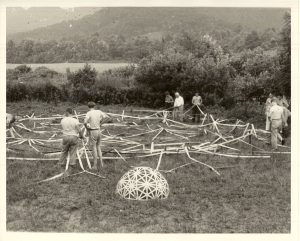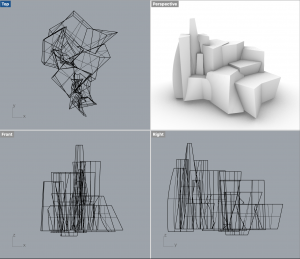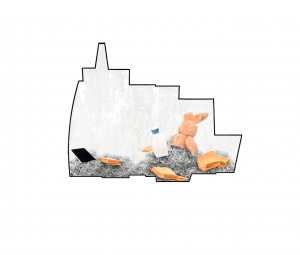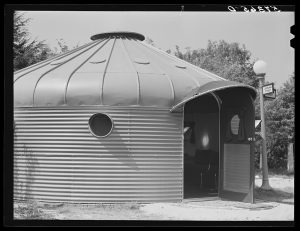5 Connor Ettinger on Buckminster Fuller
Introductions
Connor Ettinger is a 19 year old sophomore at the University of Washington, Seattle. A student enamored by all forms of art, he has spent much of his time playing music, and will be applying to his university’s Architectural Design program this March. He has been lucky enough to travel the world numerous times, and hopes to continue expanding his perspective for the rest of his life.
Buckminster Fuller (1895-1983), was an American architect and an artist, a philosopher and a pragmatist, in his own words, an Anticipatory Design Scientist. Spending a number of Summer Sessions at the Black Mountain College, Fuller’s designs have had a wide reaching and tangible effect on the modern world. He tasked himself with tackling the world’s problems, seeing how much change one person could effect over the course of their life.
A Letter to the Artist
Dear Buckminster Fuller,
Why do we make? I’m writing to you for an answer, but I also hope that in writing, I might arrive at one myself. I’ve sat in my room for a number of weeks asking myself this question. The time I spend in front of a piece of paper or a computer screen astounds even me. For one reason or another, often school, I have to make something, I have to create. Living in the 21st century, the amount of new design is almost nauseating, and the constant flow of information into our brains has me wondering what it is all for. A new smartphone comes out seemingly every week, new computers, televisions, all for a price. An unfortunate truth that I seem to be moving towards is that the process of design is weighted—it takes time and money. The unfortunate entanglement of making and modern day profit means a somewhat more complicated design process than I used to envision. Once again I return to why I’m writing to you. I want a change of perspective, and you might be able to offer that.
I suppose that I consider myself a design student. I spend hours each day attempting to create something meaningful, something that I can imbue with my own personality and intent. When I put pencil to paper or press a key on my keyboard, I am expending energy and resources with the goal of generating something. At the moment, I do wonder what I am saying with my creations—why I put a roof over this structure, why this wall is glass, why everything just ends up being a big box—these questions tend to bog down my design. The most obvious and practical answer for why I design is for a grade, to get into a design program, and it’s the only thing clouding my mind these days, but I wouldn’t like it to always be like that. In many ways, I find that I’m very averse to failure, a practice that I see as detrimental in the future. Were I to make excuses, I would say that the timescale for all of my work doesn’t exactly allow for me to take my time in creating something that speaks to who I am.
You have been able to, over the course of your life, craft some sort of a perspective. From a disillusioned veteran with his own one-man company, to a world renowned designer, you’ve traveled a wild path to reach the end of your career1. If I had to describe you, you would be an engineer, and a designer, an architect, an artist, a thinker and more. You’re a visionary who roots their thought in the fundamental truths found in the present. You have found a way to encapsulate all of the above characteristics into the persona of an Anticipatory Design Scientist. You have often shared your beliefs in human kind to weather impending ecological disasters. Though the thing I find most interesting is that, in the light of all this, you still acknowledge the ironic helplessness of humanity as a baseline. In one of your 1975 series of lectures, titled “Everything I Know,” you lament that “There is a strange vanity of man, and I think the vanity that he has, was essential to his being born naked and helpless, and having to make the fantastic number of mistakes he had to make in order to really learn something”2. This commentary interests me in the context of your mindset around design, how human beings have failed countless times in their adapting to the planet, “deceiv[ing] himself a great deal,”2 in the process. Man’s tenacity to continue problem solving is inspiring. Is this perceived foolishness to believe in the future the very thing that you’ve tried to hone? Important to note, I think, is how long it must have taken you to reach this conclusion, these lectures being from so late in your career. It makes me wonder if you’ve always held onto such an optimistic point of view. This in mind, I want to take a look at why you create, and how I might be able to learn from it.
Do I think the world is perfect? No. Do I think it can be perfect? I’m still not so sure. Maybe in that way we differ. The world in 2021 is a complicated situation. A pandemic, violent climate change, and unfettered greed see the planet heading in a dangerous direction. I think that I am a pessimist, maybe too much so, and I’d like to see through your eyes for a time. I hope that maybe it will remind me of what I love so much about creating. I once heard you lamenting on the many technological advances occurring throughout your lifetime, man taking flight, reaching the poles of the planet. In a way, it is indicative of your view of human capacity in general, and as you add, again in 1975, that “impossibles are happening,”2 surely they are in a way that isn’t stopping,
There’s a famous picture of you, spending a summer session at the Black Mountain College in the late 1940s. This is at an interesting point in your path, caught somewhere in between a burgeoning career and wide scale stardom. In that way, I’m sure the summers that you spend at the college were extremely formative to your life. Surrounded by students, you construct your prototype for the geodesic dome, a structure minimal in material that maximizes use. In your own words, the dome “ is very much stronger and more efficient than other ways of enclosing space,”4 a design with the capacity to be very much world changing.

The prototype is constructed of a number of pieces of cloth, all attached in a specific way so that you hope will see the dome rise on its own by means of tension (tensegrity as you call it—in your words from 1928 “utilizing gravity instead of opposing it”5). This has been a long project of yours, over the span of a number of decades, and in this moment you hope to see a success. You finish the construction, step back and wait. What must’ve felt like an eternity, those few moments would eventually end in disappointment, the structure failing to rise from the ground, staying stagnant as a collection of intricately connected cloths. What did that moment feel like? To take a prototype to such a finished point to see it not work must have been demoralizing, and it amazes me how committed you were to finishing the design. I feel that when I settle on some sort of perfect design, I tend to falter in the middle, especially if the idea doesn’t entirely pan out.
Clearly, it must not have discouraged you all too much. At the BMC, you perfected your design, and its wide scale implementation came soon afterward thanks to the US military5. The choice to focus on suspension through tensegrity, serves as a model for design problem solving in the modern world, and the commitment to see it through to its finished product is rather commendable in its own right. I suppose that commitment comes from your goal to create a perfect world, to make more with less, to be free of the shackles of politics (or “we’re licked”3 as you put it). Today, you’ll find hundreds of thousands of geodesic domes across the planet. It’s in many ways tantalizing to think about the possibility of an idea, given the proper care and resources.

Ironically, I’ve been trying my hardest to evoke your spirit in my recent ventures. I have an architectural studio course where our latest project is asking us to build a structure that holds the “idea” of and reflects on how my culture views water. It might be a bit of a high brow topic, but I’ve tried to ground myself. In some ways, I find some need to be realistic in the things that I create—I don’t exactly expect to have the backing of the US military and countless “unsolicited checks,” as you did with your geodesic dome5, when designing my water storage facilities. There’s a definite conversation to be had about having the privilege to design, and whether that affords a responsibility or demands a certain humility, but I digress.
I took a course this quarter called The Politics of Making. For one of our assignments, we designed our own time capsules, to be opened 100 years from now. Beyond that, the project was open ended. Immediately, my mind went to the ecological. In my view, what will be remembered in a century won’t be what this generation made, but what it used—the waste we’ve accumulated and the impact that it will have had on the environment. My capsule takes a jagged shape, reminiscent of a city skyline or maybe the form of a massive trash heap. Inside, I planned to have it filled with things that have had their lifetimes expended: broken electronics, shreds of paper, single use plastics, and broken children’s toys.


My intent behind the project was to send a serious message about the capitalist, consumerist culture that is causing the degradation of our planet. It would be interesting to see the capsule opened in 100 years, to know what kind of planet exists then, and if my time capsule would have signaled the end of a wasteful era, or foreshadowed a dark ecological future. This work contrasts to much of your own because it doesn’t have much in the way of practical use. Whereas your projects are to the goal of improving human lives on the planet in a tangible way, this time capsule is symbolic. Overall, I’m happy with what the time capsule means, and I believe that I have been able to present it in a convincing way, but I also hope that my work in the future moves farther towards your side of the spectrum—the practical, the type of designs that are meant to affect human lives in a positive way.
As I’ve previously noted, your ideas and designs are clearly rooted in a sort of pragmatism, a desire to build with less, to create a form that can be easily replicable in a way that can easily improve living standards. The problem of food security in a growing population is clearly a massive one, but it surely gave you grounding when you first stumbled upon it after your time in the military1. The work of yours that comes to mind is the Dymaxion House. Rather than just sending a message about environmentalism, this work attempts to create a practical solution. With its relatively simple materials and on-site construction, I’m blown away by its concept, as were others—one man reportedly remarking about your work, “My God, this is the house of the future!”5. In my own creative process, I think I have a habit of getting lost in my contrived personal aesthetics, trying to find some abstract beauty in my own work that communicates to beauty in the eyes of others. What I find myself failing to acknowledge is the necessary practical uses of the built environment.

The collision of art and science is a topic that you’ve often explored, searching for some middle ground in between the two. “The great scientists and great artists are not only subjective and pure but also objective and responsible inventors…Because of a comprehensive outlook, their art reflects the many disciplines, especially science…The only ones who don’t get trained for specialization are artists, they want to be whole.”6 I think that aesthetics and pragmatism have a natural meeting place, though I don’t think I’ve found it. Maybe the concept of making something has found itself trapped between two uses, that for need and that for use, when it could be that those aren’t all too different. In that way, the mingling of art and science doesn’t seem too outlandish. Though, I doubt I will be able to reach that connection for a long time.
I’ve given a lot of thought to why we make, and I’ve come to the conclusion that there isn’t any one clear reason. It’s frighteningly open ended. I suppose that, at a baseline, we create in response to a need or a want—the lack of shelter, for example. These needs vary though. You feel an altruistic need to better the lives of people on Earth, and for me, I think I’m still discovering my need or want. These factors change too: comparing the rather more streamlined vision of your 4D company founded in 19271 to your focuses later on in the 1900s, your specific aspirations appear to shift from time to time, thought the central guiding mission always remains intact, to adapt humanity to best suit the world we’ve been given. I hope to one day find a driving factor as visceral as yours.
I often wonder about how one develops a “style.” Clearly, your work follows some guiding principles. From your domes in Antarctica to your Dymaxion map and its World Game, design motifs show up throughout your work. The collaboration and streamlining of shapes emphasizes how you see the universe and how it comes forward in your design. I think that, if you have a style, it is more defined by why you want to make and what you make. Developing a sort of artist’s touch on your own work was rooted in the design principles you developed—tensegrity, for example, is rooted in natural forms: “These [Dymaxion] homes are structured after the natural system of humans and trees with a central stem or backbone, from which all else is independently hung, utilizing gravity instead of opposing it. This results in a construction similar to an airplane, light, taut, and profoundly strong”5. If you have a style, it comes through in the striking geometric character of your works, and how that reflects the world we live in. How did your own style manifest? Do you even have a style, or do you strictly adhere to the needs that drive a project?
I suppose that, in many ways, one’s own “style” is simply a reflection of their design convictions and philosophies. Yours are rooted in pragmatism and it is reflected in your designs: their simple, replicable composite parts made of easily used materials show a desire to mass produce for human need in a way that collaborates with rather than destroys the environment. I suppose that’s why I feel so erratic in my designs—I don’t have a philosophy formed yet, I’m still searching for my own version of “make more with less.” Once I find my drive, my reason for creation, I hope that I will see it manifest in its own notable style. Further, I wonder about the role of failure in forming one’s own design touch. I see some failures in your own work. Even the geodesic dome had its humble beginnings at the Black Mountain College, long before it became the architectural dialect that we know inhabits the world today.
I think that as a designer, I aspire to be like you, to see designs through because of an unwavering conviction, to allow that conviction to shape projects, in turn creating your own notable style. I want to learn more about the role of design, art and technology from your point of view. At one point, you were quoted saying, “That we have that kind of capability, despite our absolutely negligible magnitude physically, that we can deal with our minds in such magnitudes and do so quite reliably gives us a hint that human beings must have some very great significance in the scheme”7. With such an unrelenting belief in the human capacity, I’m sure it isn’t so difficult to dream a little bit bigger.
Best,
Connor Ettinger
Media Attributions
- Supine Dome © Beaumont Newhall is licensed under a Public Domain license
- Montréal Biosphere © Ralf Roletschek is licensed under a CC BY-NC-ND (Attribution NonCommercial NoDerivatives) license
- Connor Ettinger, ‘Time Capsule,’ 2021, Rhino CAD
- T Capsule Int El Render
- Dymaxion House © Marion Post Wolcott is licensed under a Public Domain license
-
1. Anker, Peder. “Buckminster Fuller as Captain of Spaceship Earth.” Minerva 45, no. 4 (2007): 417–34. https://doi.org/10.1007/s11024-007-9066-7.
2. Fuller, Buckminster. “Session 1.” Everything I Know. Lecture, January 1975. Accessed through https://web.archive.org/web/20201025061202/https://www.bfi.org/about-fuller/resources/everything-i-know/session-1
3. Fuller, Buckminster. “Session 2.” Everything I Know. Lecture, January 1975. Accessed through https://web.archive.org/web/20200707040009/https://www.bfi.org/about-fuller/resources/everything-i-know/session-2
4. Smith, Howard Michael, and Fred L. Bookstein. The Smith Tapes: Lost Interviews with Rock Stars & Icons 1969-1972. New York: Princeton Architectural Press, 2015.
5. “Geodesic Domes” About Fuller | The Buckminster Fuller Institute, January 1, 1970. https://web.archive.org/web/20210116183210/https://www.bfi.org/about-fuller/big-ideas/geodesic-domes.
6. “R. Buckminster Fuller, 1895-1983” About Fuller | The Buckminster Fuller Institute, January 1, 1970. https://web.archive.org/web/20210226221350/https://www.bfi.org/about-fuller/biography/.
7. “Big Ideas” About Fuller | The Buckminster Fuller Institute, January 1, 1970. https://web.archive.org/web/20200925110506/https://www.bfi.org/about-fuller/resources/articles-transcripts/big-picture-thinking.
↵

